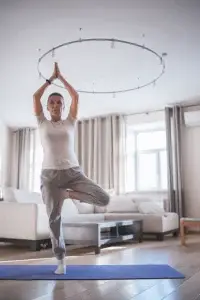
Creating Better Lives for Seniors with Accessible Tech
Image by Freepik for Creating Better Lives for Seniors with Accessible Tech Creating Better Lives for Seniors with Accessible Tech Technology has the power to
How Long Should You Be Able to Stand on One Leg, According to Your Age?

Maintaining balance is essential for everyday activities, and standing on one leg is a simple yet effective way to assess your balance and overall health. The big question today is how long should you be able to stand on one leg, according to your age. This ability tends to diminish with age due to factors like muscle loss, reduced coordination, and changes in inner ear function. Here’s a breakdown of how long you should be able to stand on one leg based on your age, and tips to improve your balance.
If you’re in this age range, you should aim to stand on one leg for about 30-45 seconds. Younger adults typically have better muscle strength, coordination, and balance. However, modern lifestyles often lead to long periods of sitting, which can affect balance and overall fitness. Incorporating balance exercises into your routine can help mitigate these effects.
Tips for Improvement:
For those aged 50-69, standing on one leg for 20-30 seconds is a good benchmark. As you age, muscle mass and bone density decrease, which can impact balance. It’s important to remain proactive in maintaining strength and stability.
Tips for Improvement:
For seniors aged 70 and above, standing on one leg for 10-20 seconds is considered a good indicator of balance. This age group is more susceptible to falls, which can lead to serious injuries. Therefore, maintaining balance is crucial.
I’d hate to be here [at home], just decomposing, and nobody knows you’re there.
Check out our Automated Safety Welfare Check In Care Calls to day and you’ll never be left to decompose!
Organize Your Daily Safety Call Right Now
No Contracts. Cancel Any Time, No Risk
Tips for Improvement:
Improving balance isn’t just about standing on one leg for longer periods. It has several health benefits, including:
Maintaining and improving your balance is important at any age. Regularly practising balance exercises and staying active can help you achieve and maintain these benchmarks. Remember, it’s never too late to start working on your balance. Whether you’re 20 or 70, incorporating balance exercises into your routine can lead to a healthier, more active lifestyle.
For personalized advice, consider consulting with a fitness professional or physical therapist who can tailor a balanced program to your specific needs and abilities. Stay balanced, stay healthy!
Summary How Long Should You Be Able to Stand on One Leg, According to Your Age?
The ability to stand on one leg can be a good indicator of balance and overall health, and it tends to decline with age. Here’s a general guideline based on age:
These times can vary based on individual fitness and health conditions. Working on balance exercises to maintain and improve this ability as you age will only improve your ability to avoid falling.




Image by Freepik for Creating Better Lives for Seniors with Accessible Tech Creating Better Lives for Seniors with Accessible Tech Technology has the power to

How Long Should You Be Able to Stand on One Leg, According to Your Age? Maintaining balance is essential for everyday activities, and standing on

Flourishing in Your Golden Years: Embrace Health and Vitality Even answering your daily automated safety welfare check in care call while out and about. Image

ⓒ All rights reserved